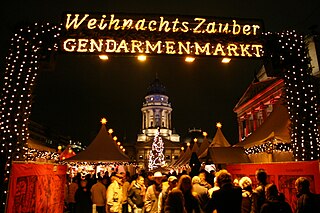
Berlin is the capital and largest city of Germany, by both area and population. With over 3.85 million inhabitants, it has the highest population within its city limits of any city in the European Union. The city is also one of the states of Germany, being the third smallest state in the country by area. Berlin is surrounded by the state of Brandenburg, and Brandenburg's capital Potsdam is nearby. The urban area of Berlin has a population of over 4.5 million and is therefore the most populous urban area in Germany. The Berlin-Brandenburg capital region has around 6.2 million inhabitants and is Germany's second-largest metropolitan region after the Rhine-Ruhr region, and the fifth-biggest metropolitan region by GDP in the European Union.

U5 is a line on the Berlin U-Bahn. It runs from Hauptbahnhof in Mitte eastwards through Alexanderplatz, Friedrichshain, Lichtenberg and Friedrichsfelde, surfaces in Biesdorf-Süd to pass Kaulsdorf and Hellersdorf above ground and finally reaches city limits at Hönow.

The Berlin tramway is the main tram system in Berlin, Germany. It is one of the oldest tram networks in the world having its origins in 1865 and is operated by Berliner Verkehrsbetriebe (BVG), which was founded in 1929. It is notable for being the third-largest tram system in the world, after Melbourne and St. Petersburg. Berlin's tram system is made up of 22 lines that operate across a standard gauge network, with almost 800 stops and measuring almost 190 kilometres (120 mi) in route length and 430 kilometres (270 mi) in line length. Nine of the lines, called Metrotram, operate 24 hours a day and are identified with the letter "M" before their number; the other thirteen lines are regular city tram lines and are identified by just a line number.

Mohrenstraße is a Berlin U-Bahn station on line U2, located in the district of Mitte.

Marzahn is a locality within the borough of Marzahn-Hellersdorf in Berlin. Berlin's 2001 administrative reform led to the former boroughs of Marzahn and Hellersdorf fusing into a single new borough. In the north the Marzahn locality includes the neighbourhoods of Bürknersfelde and Ahrensfelde, an overbuilt strip of land which once had belonged to the Brandenburg municipality of Ahrensfelde and was incorporated into Berlin in 1990.

Kienberg is a station on the U-Bahn in the German capital city of Berlin. It is located on the U5 line.

Heinrich-Heine-Straße is a Berlin U-Bahn station on the U8, located under the street of the same name in Mitte, and protected as an architectural landmark. The street and the station were called Neanderstraße until 1960.
The Bundesgartenschau is a biennial federal horticulture show in Germany. It also covers topics like landscaping. Taking place in different cities, the location changes in a two-year cycle.

The Britzer Garten is a large park in Berlin, named after Britz, a neighborhood of the borough of Neukölln. It was constructed for the Bundesgartenschau 1985, in order to provide a new landscape park to the citizens in the southeast of West-Berlin, who were at that time cut off from the surrounding countryside.

Berlin has developed a highly complex transportation infrastructure providing very diverse modes of urban mobility. 979 bridges cross 197 kilometers of innercity waterways, 5,334 kilometres (3,314 mi) of roads run through Berlin, of which 73 kilometres (45 mi) are motorways. Long-distance rail lines connect Berlin with all of the major cities of Germany and with many cities in neighboring European countries. Regional rail lines provide access to the surrounding regions of Brandenburg and to the Baltic Sea.

Bus transport is the oldest public transport service in Berlin, the capital city of Germany, having been introduced in 1846. Since 1929, services have been operated by the Berlin Transport Company, although during the Cold War-era division of the city they operated in West Berlin only. In East Berlin the public transport agency split off from the BVG and rebranded as BVB, operating the buses in the Soviet sector of Berlin.

Gärten der Welt is a public park in Marzahn, Berlin. It was opened on 9 May 1987 as Berliner Gartenschau and was renamed Erholungspark Marzahn in 1991, before adopting its current name in 2017. The total area encompasses more than 100 hectares.

The East Tangential Link - in German Tangentiale Verbindung Ost (TVO) - is a road project connecting the Eastern boroughs of Berlin, Germany. It was fully described in the Transport Master Plan for the GDR Capital in 1969 but it is unfinished to date. The original six lane expressway design has been cut back over time.

The Wriezen Railway is a line in the northeast of the German states of Berlin and Brandenburg. It runs from Berlin to Werneuchen and formerly extended via Wriezen to Jädickendorf. Its terminus in Berlin from 1903 to 1949 was the Wriezener Bahnhof. The predominantly single-track line has operated only between Berlin-Lichtenberg station and Werneuchen since December 2006.

Berlin is a city-state and the capital of the Federal Republic of Germany.

The IGA Cable Car, also known as Berlin Cableway, IGA Ropeway or IGA Cableway, is a 1.58 km (0.98 mi)-long gondola lift line serving and crossing the Erholungspark Marzahn in Berlin, capital of Germany. Built for the Internationale Gartenausstellung 2017, an international horticultural exhibition, it is the first cableway opened in the German capital.

There are over 80 Christmas markets in various parts of Berlin, where craftspeople demonstrate their skills and sell their wares along with many other Christmas gifts and fairground attractions. The first Christmas market took place in 1530 in Alt-Berlin.

Stefan Liebich is a German politician, who served as a member of the Bundestag for the Democratic Socialist party The Left between 2009 and 2021.

Mario Czaja is a German politician of the Christian Democratic Union (CDU) who has been serving as a member of the German Bundestag since the 2021 elections.


















